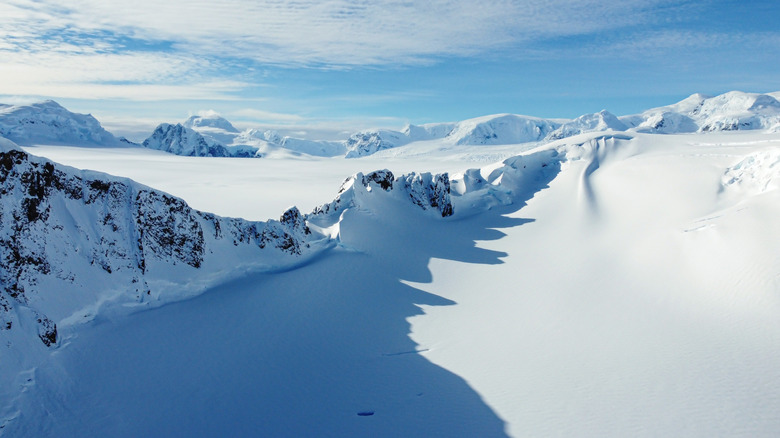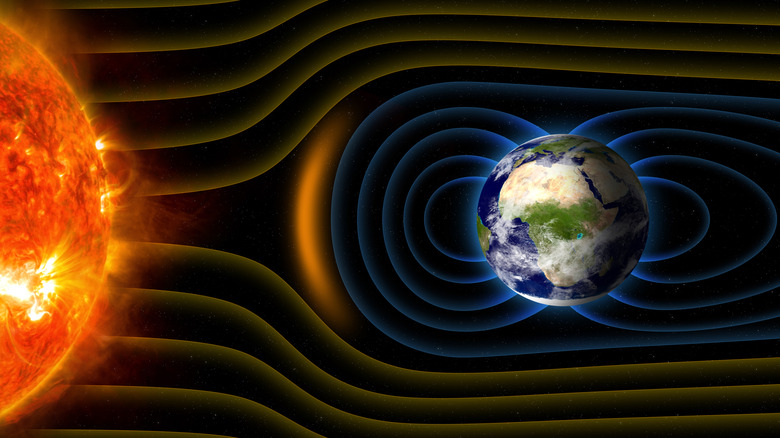Here's One Big Reason Why Planes Don't Fly Over Antarctica
Every day, approximately 100,000 planes take off and land at airports around the world, but none of those flights pass over Antarctica. An oft-cited reason for this absence is a lack of demand. The vast majority of the human population lives in the northern hemisphere, and over 90% of flight miles covered each year are north of the equator. However, even if you wanted to fly between Australia and South America, a trip for which the most direct route would be straight across Antarctica, you still wouldn't be able to find a flight that goes over the southernmost and fifth-largest continent. Instead, planes heading between those destinations skirt along the coast of Antarctica, never straying far over the landmass itself.
For flyers, it may sound frustrating. Why should you have to take a longer flight path while simultaneously being denied the opportunity to take some sweet aerial photos of the ice-covered continent? Part of the issue is regulatory: Laws dictate that all planes must stay within a certain range of a functioning airport in case they need to make an emergency landing, and there are no commercial airports on Antarctica. However, the real question we should ask is why we lack this infrastructure to begin with, and that all comes down to the Antarctic environment. Antarctica is the world's largest desert, and deserts are notoriously windy spaces. That's a problem for pilots, and the air over Antarctica is some of the roughest in the world.
The fearsome winds of Antarctica
The biggest problem with flying over Antarctica is that it's the windiest place on the planet, with wind speeds up to 200 miles per hour. This is due to an unusual phenomenon in the troposphere (the lowest level of the atmosphere, where weather events like wind and storms occur) above the continent. Typically, temperatures in the troposphere decrease with altitude because the higher you go, the less dense the air is. At ground level, the average global temperature is around 60 degrees Fahrenheit, but at the top of the troposphere, it's around -60 degrees. However, the surface temperature of the interior of Antarctica is even colder than that, averaging around -70 degrees.
The surface of Antarctica is so cold that higher in the troposphere, the temperature actually gets warmer. Cold air naturally sinks, and because Antarctica has the highest average elevation of any continent, all that freezing surface-level air ends up cascading down through the rifts of the continent's rough landscape, turning into powerful katabatic winds. These brutal winds batter aircraft and ships, creating hazardous conditions, and if a plane is unable to make it through the gale, they're unlikely to find a safe landing spot anywhere nearby. And one more thing about that frigid air: jet fuel freezes between -40 and -58 degrees Fahrenheit, well above the average Antarctic temperature, and although planes' insulation works to protect the fuel, long-term flights across the entire continent could prove too much, resulting in disaster.
Flying near the poles also carries a radiation risk
Fearsome winds, which could arise at any moment, would present an immediate threat to planes flying over Antarctica, but there is another force that poses a more sinister, slow-burning danger. Every moment of every day, Earth is being bombarded by cosmic radiation generated by the sun, as well as other stars whose radiation extends into our own solar system. Prolonged exposure to cosmic radiation carries a high risk of cancer in humans, but fortunately Earth's magnetic field deflects almost all radiation before it can reach us on the ground. However, the magnetic field is weak around the poles, allowing more radiation to get through; plus, higher altitudes increase radiation exposure, meaning that any plane flying over the South Pole would be in double danger.
A single flight across Antarctica would keep passengers within a safe level of radiation, but repeatedly flying across the poles could cause radiation to accumulate, bringing with it the risk of cancer and reproductive damage. This would be a significant threat to pilots and flight attendants who might fly along the same route several times. Although there is still some debate over the exact impact of cosmic radiation on the body, it appears to be a legitimately deadly risk. In 2023, a court in Korea ruled that cosmic radiation exposure was the direct cause of a flight attendant's death by stomach cancer. With stories like these emerging, pilots could very well be worried about even attempting flights across Antarctica.


